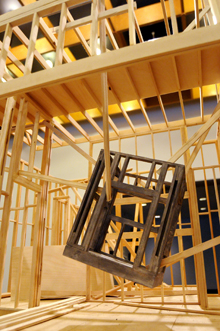
WOODEN GEOMETRIES A detail of Laustsen's Emergence.
|
For several years, Woonsocket sculptor Jon Laustsen has demonstrated a curious and original vision with a series of model construction sites that resembled 1/8-scale roller coasters, or perhaps the outer wall of the Providence Place Mall, or a landscape of miniature buildings with one at the end mysteriously torched. Now an installation — his largest yet — filling the lobby of Brown University's Bell Gallery for the group show "Voice Over" (64 College Street, Providence, through July 11) confirms by its complexity and scale and ambition that he's one of the best sculptors working in the region.
In Emergence, construction motifs mutate, multiply, and take on lives of their own. The main structure features full-sized beams that might begin a floor, raised off the lobby by reinforced concrete columns. But instead of floorboards, they support the wood framing for miniature rooms, resembling models for Modernist houses, linked by bridges. The rooms don't connect up right and their function is mysterious. The top room of a two-story structure at the center has a rectangular hole in the floor that becomes a stairwell, but there are no stairs and probably not room for any. The room below encases a telephone booth-shaped box rising through a round hole in the floor. A braided cord runs down from it into a concrete box on the floor slathered with orange foam, like elemental fires.
An actual-sized wooden gangplank invites you to walk up to this main structure. On either side stand actual-sized sand and plaster models of earth (Laustsen tells me he made it by scaling up modeling techniques to life size) with low gray fences rising from them. They are batter boards, often the first structures driven into the ground to mark the boundaries of a new foundation.
More than in previous works, Laustsen shifts scale between miniature and actual size. This tempers the preciousness that can infect model making, and short circuits your thinking. (This is cerebral rather than emotional sculpture.) You want to read it as big or little, but the two scales together cancel out the logic of either one and make you contemplate it as something else.
Laustsen's simple wooden geometries echo '60s Minimalism's use of primary structures and industrial materials. Laustsen also channels the redevelopment of "Renaissance City" Providence. This has been a significant theme in Providence art — from numerous posters to Scott Lapham's photos of the demolition of old mills to Neal Walsh's abstract canvases with the feel of old dilapidated walls to the Trummerkind gang's secret apartment at the Providence Place mall.
"I have this memory of being about 4 and walking through a rehabbed house and you didn't have to walk right or left, you could just walk through the [unfinished] walls," Laustsen tells me. "It's the structure as well as the unfinishedness that I'm interested in. And the spaces that come of that . . . ambiguous space is more interesting to me than finished space that guides you through."
"Voice Over," which was guest curated by RISD sculpture professor Dean Snyder, also includes well-crafted work by Amy Podmore of Williamstown, Massachusetts, and Charles Jones of Boston.